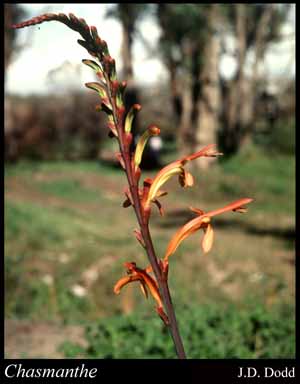- Reference
- Trans.Roy.Soc.South Africa p272 (1932)
- Name Status
- Current







Scientific Description
Family Iridaceae.
Habit and leaf form. Herbs (medium to large); evergreen, or deciduous. Perennial (annual leaves and flowers). Leaves basal, or basal and cauline. Plants with a basal concentration of leaves, or with neither basal nor terminal concentrations of leaves; cormous (large, depressed-globose, fibrous tunic). Helophytic to xerophytic. Leaves alternate; distichous; ‘herbaceous’, or leathery; sessile; sheathing. Leaf sheaths with free margins. Leaves foetid, or without marked odour; edgewise to the stem, or with ‘normal’ orientation; simple; epulvinate. Leaf blades entire; flat; linear, or lanceolate; elliptic (basal, narrowly elliptic to ensiform); parallel-veined (prominent asymmetric midvein); without cross-venules; open or closed sheaths. Leaves eligulate; without stipules. Leaf blade margins entire. Leaves with a persistent basal meristem, and basipetal development. Leaf anatomy. Hairs absent. Extra-floral nectaries absent. Stem anatomy. Secondary thickening absent.
Reproductive type, pollination. Fertile flowers hermaphrodite. Unisexual flowers absent. Plants hermaphrodite. Floral nectaries present, or absent. Nectar secretion from the perianth (from nectaries at the tepal bases). Entomophilous, or ornithophilous, or anemophilous.
Inflorescence and flower features. Flowers aggregated in ‘inflorescences’; in spikes. The terminal inflorescence unit cymose, or racemose. Inflorescences terminal; scape erect, robust, branched or unbranched; inflorescence distichous or secund, many-flowered; spatheate (2 per flower, short). Flowers sessile; bracteate (2 enclose each flower, spathe-like, persistent, short, inserted at the base of the ovary, herbaceous with dry membranous margins; inner shorter than the outer; inner apex shortly divided). Bracts persistent. Flowers ebracteolate; small to large; very irregular; when irregular, zygomorphic; 3 merous; cyclic; tetracyclic. Perigone tube present. Perianth of ‘tepals’; 6; 2 -whorled; isomerous; petaloid; without spots, or spotted; similar in the two whorls, or different in the two whorls; yellow (sometimes), or orange (to red). Androecial members definite in number. Androecium 3. Androecial members adnate; markedly unequal; free of one another; 1 -whorled (representing the outer whorl). Androecium exclusively of fertile stamens. Stamens 3; all more or less similar in shape; reduced in number relative to the adjacent perianth to isomerous with the perianth; on the perianth tube at the base of the wider part, opposite the outer perianth segments; alterniperianthial (opposite the outer perianth lobes). Anthers basifixed (or sub-basifixed); versatile; dehiscing via longitudinal slits; extrorse. Gynoecium 3 carpelled. The pistil 3 celled. Gynoecium partly petaloid, or non-petaloid; syncarpous; synstylovarious; inferior. Ovary plurilocular; 3 locular. The ‘odd’ carpel anterior. Gynoecium stylate. Styles 1; apical. Stigmas 3. Placentation axile. Ovules few; arillate, or non-arillate; anatropous.
Fruit and seed features. Fruit non-fleshy; dehiscent; a capsule. Capsules loculicidal (from the apex). Fruit 3 celled; few. Seeds endospermic. Endosperm oily. Cotyledons 1 (coleoptile-like). Embryo straight (small). Testa without phytomelan.
Etymology. From the Greek for "gaping" and "flower", referring to the shape of the bilabiate perianth.
Taxonomic Literature
- Wheeler, Judy; Marchant, Neville; Lewington, Margaret; Graham, Lorraine 2002. Flora of the south west, Bunbury, Augusta, Denmark. Volume 1, introduction, keys, ferns to monocotyledons. Australian Biological Resources Study.. Canberra..
- Australia. Bureau of Flora and Fauna 1986. Flora of Australia. Volume 46, Iridaceae to Dioscoreaceae. Australian Govt. Pub. Service.. Canberra..